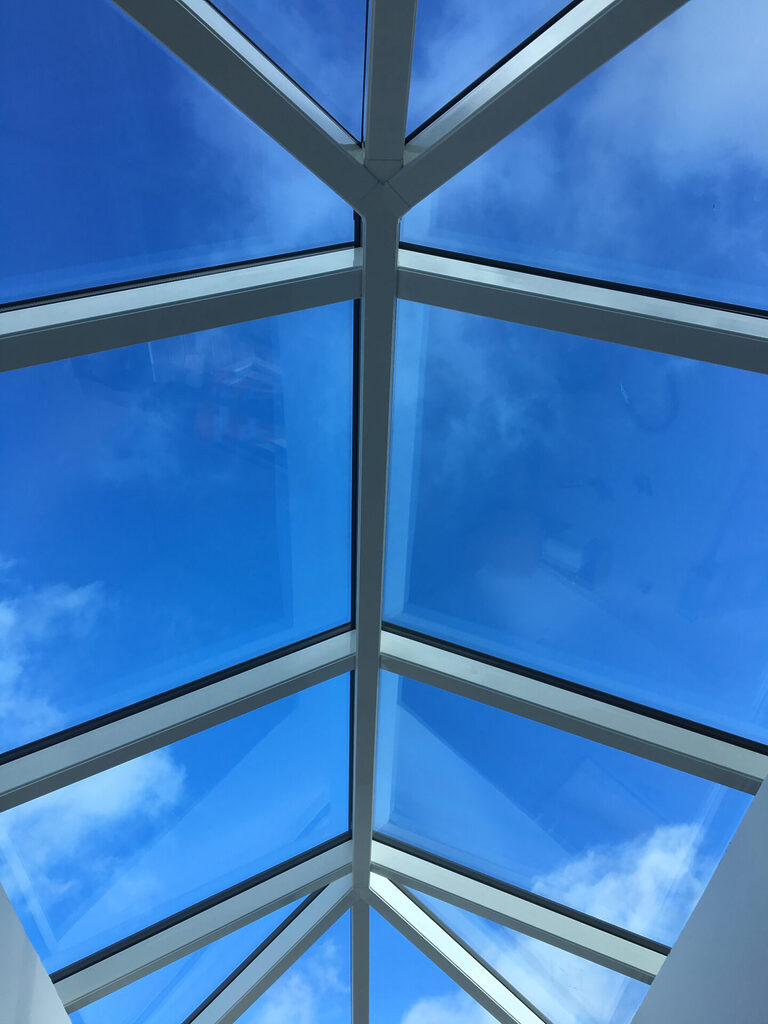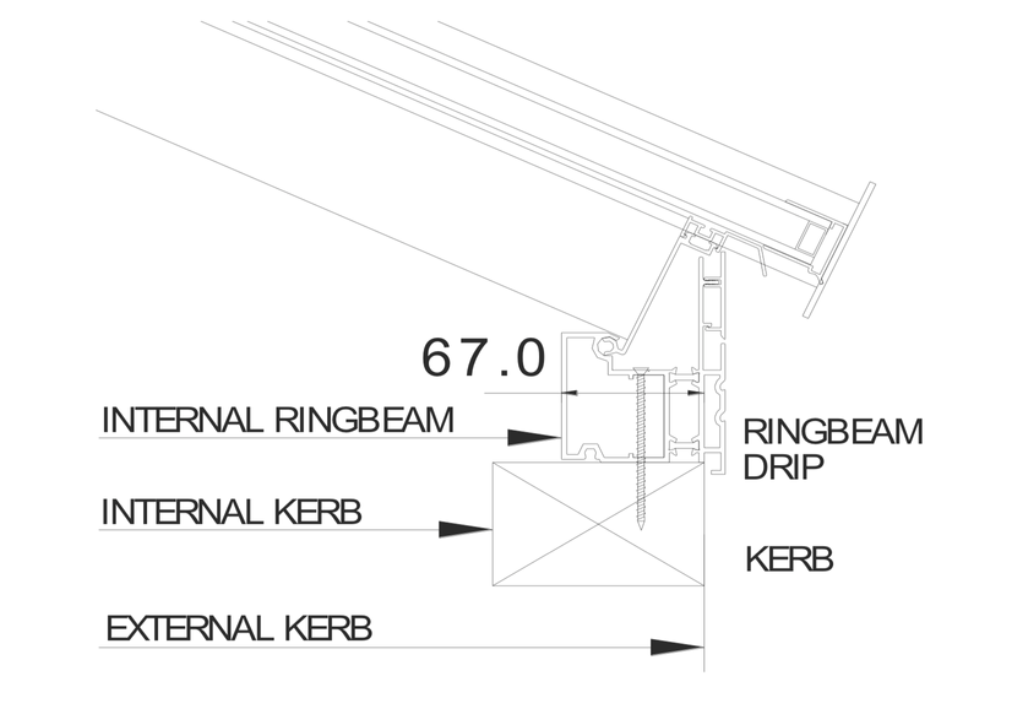Last Updated on 15 November 2024 by Tia Ellahi
Roof lanterns are a fantastic addition to any home, offering not just practical benefits like increased natural light and ventilation, but also adding a touch of architectural elegance; however, to ensure a perfect fit and seamless installation, precise measurements are essential.
In this comprehensive guide, we’ll take you through the step-by-step process of measuring for a roof lantern, covering everything from basic dimensions to considering structural elements and regulations.
If you’re feeling a little overwhelmed and have some questions, feel free to contact our team on 01642 309576 for guidance and support.
Need something in a hurry? Jump ahead:
- What you need to measure for a roof lantern
- How to measure for a roof lantern
- Measuring best practices
- Perfectly fitted roof lanterns
- FAQs
What you need to measure for a roof lantern
Before you start measuring, make sure you have the following tools within reach:
Tape measure
A good quality tape measure is essential for accurate measurements.
Ladder
Depending on the height of your roof, you may need a ladder to access the area safely.
Pencil & Paper
Keep these handy for jotting down the measurements, as well as any notes you may want to take along the way.
How to measure for a roof lantern
To measure for a roof lantern, you’ll need to do the following:
Always remember that the measurements required can vary depending on the specific model you purchase. Therefore, it’s crucial to check with the supplier or manufacturer first to ensure you take the correct dimensions for your chosen lantern.
Measuring the roof opening
Start by measuring the width and length of the roof opening from the inside. Measure at least three times to ensure accuracy, as even small discrepancies can lead to problems later on.
Note down the largest measurement to ensure the roof lantern will fit comfortably.

For any of our GFD Homes roof lanterns, you’ll just need to supply the external kerb measurement.
Accounting for roof pitch and angle
Next, consider the pitch or angle of your roof. This will affect the size and shape of the roof lantern.
Measure the angle accurately using a level or protractor, as this information is crucial for ordering the correct size and ensuring a seamless fit.
Measuring external kerb dimensions
Measure the external kerb dimensions, taking into account any protrusions or obstructions that may affect the placement of the roof lantern. It’s essential to measure both the width and depth of the kerb to ensure the roof lantern sits flush and securely.

Here’s an image from our Atlas roof lantern measuring guide showing the external kerb.
Allow for frame and structural support
Factor in the frame and structural support of the roof lantern. Consider the thickness of the frame and any additional supports required for installation. Make sure there is enough space around the roof opening to accommodate these elements without compromising the structural integrity of your roof.
Leave space for installation
Ensure there is ample space around the roof opening for installation. Proper ventilation is crucial to prevent condensation and maintain optimal indoor air quality. Leave enough room for air to circulate freely around the roof lantern, especially if it’s located in a kitchen or bathroom.
For our Korniche roof lanterns, we suggest adding 12mm to each external kerb measurement as this will create an overhang for drainage.
Roof lantern measuring best practices
When it comes to measuring your roof lantern, don’t forget to follow these best practices:
Measure twice for accuracy
Double-check all measurements to ensure accuracy. It’s better to spend a little extra time measuring than to encounter problems during installation due to incorrect dimensions, such as roof lantern leakage.
When it comes to enhancing natural light in your home, fitting a roof lantern can be a fantastic option.
Consult with roof lantern experts
If you’re unsure about any aspect of the measuring process, don’t hesitate to consult roof lantern experts. They can provide valuable guidance and recommendations based on their expertise.
If you choose to purchase a lantern from our website, rest assured that measuring for installation is a breeze. With our lanterns, you’ll only need to measure the external kerb dimension, simplifying the process and ensuring a smooth installation experience.
Get Perfectly-Fitted Roof Lanterns with GFD Homes
At GFD Homes, we’re all about delivering top-notch, custom-fitted roof lanterns. Our team of experts is here to walk you through the measuring process, ensuring every dimension needed is just right for your project. With our support you’ll seamlessly incorporate our roof lanterns into your space, inviting in the beauty of natural light to elevate your home ambiance.
So, whether you’re looking for contemporary roof lanterns, traditional roof lanterns or even slimline roof lanterns, know that we’ve got you covered every step of the way.
For more information on roof lanterns, feel free to visit our website or check out our blog.
Prefer to check out a roof lantern in person? Call us on 01642 309576 to book a visit to our one-of-a-kind Teesside showroom.
FAQs about roof lantern measuring
What is the minimum upstand for a roof lantern?
The minimum upstand requirement varies depending on the type and size of the roof lantern.
Generally, a minimum upstand of 150mm is recommended for flat roofs to ensure proper drainage and weatherproofing; however, for pitched roofs, the upstand may need to be higher to accommodate the angle of the roof and prevent roof lantern leakage.
When it comes to our GFD Homes range, our Atlas roof lanterns have a minimum upstand of 67mm and our Korniche roof lanterns have a minimum upstand of 69mm.
Are there any specific regulations or building codes to consider when measuring for a roof lantern?
Yes, there may be regulations and building codes governing the installation of roof lanterns, especially concerning structural integrity and energy efficiency. Always check with local authorities first to ensure compliance.
Additionally, consider any roof lantern planning permission requirements, especially if you live in a conservation area or your property is listed.
How do you measure outdoor roof lanterns?
Measuring outdoor roof lanterns follows a similar process to indoor ones, with added considerations for weatherproofing and exposure to the elements. Be sure to account for these factors when taking measurements and consider opting for materials and finishes that are durable and weather-resistant.
By following these guidelines and best practices, you can ensure a seamless and successful roof lantern installation, bringing natural light and beauty into your home for years to come.
All roof lanterns in our GFD Homes range are made from aluminium and are therefore extremely durable and weather-resistant. We also offer a fantastic 10 year guarantee on every lantern we supply, giving you peace of mind long after your purchase.
